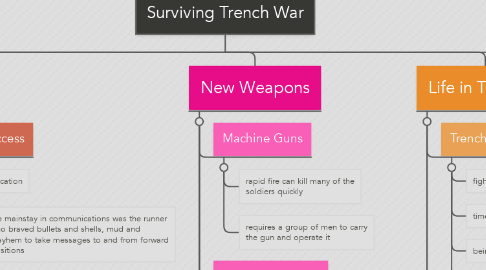
1. Causes of Trench War
1.1. Not Wanting to Loose Territory
1.1.1. Germans dug trenches at the farthest point of their advance into France
1.1.2. French and the British dug trenches that faced the Germans
1.2. Protection
1.2.1. digging into the ground = the trenches
1.2.2. Germans pulled back to the Aisne River and dug their positions
1.3. Stalement in the War
1.3.1. both sides built trenches to protect themselves in times of stalement
2. New Weapons
2.1. Machine Guns
2.1.1. rapid fire can kill many of the soldiers quickly
2.1.2. requires a group of men to carry the gun and operate it
2.2. Infantry Weapons
2.2.1. each soldier would have
2.2.1.1. a Rifle
2.2.1.2. a Bayonet
2.2.1.3. and grenades (3)
2.3. Tanks
2.3.1. bullet-proof and can mow down the barbed wire defences of the enemy
2.4. Poison Gas
2.4.1. can kill groups of people
2.4.2. however, sometimes the wind would blow the gas back
2.4.3. in order for the attack to work, gas masks were created
2.5. Artillery
2.5.1. heavy shelling normally proceeded any attack
2.5.2. 6,000 guns fired over two million shells in four hours
2.6. Air Reconnaissance
2.6.1. getting a good view of the enemy which was crucial in deciding tactics
2.6.2. observes enemies movements, size, and position
2.6.3. guides the artillery fire
2.6.4. wasn't invented until later during the war
3. Emotions
3.1. Miserable
3.1.1. Trenches were filthy and muddy
3.1.2. Trench Foot which was a medical condition; fungal infection of the feet caused by cold, wet, and unsanitary trench conditions
3.1.3. the appalling smell
3.1.3.1. rotting flesh
3.1.3.2. overflowing latrines
3.1.3.3. stench of humanity
3.1.3.4. smell of disinfectant
3.1.3.5. smells of battle (poison gas)
3.2. Depression
3.2.1. from the fifth and smell
3.2.2. constant threat of sudden death
3.2.3. psychological effect on the soldiers of the war was catastrophic
3.3. Frozen & Sad
3.3.1. any minute they can be blown into pieces
3.3.2. doubtful in what may occur don't know what else to do except do what is told
3.4. Heartbreaking and Angry
3.4.1. has to watch as one of your friends or soldiers die
3.4.2. nothing can be done to help that person but to run or you will also get killed
4. Tactics
4.1. Key to Success
4.1.1. communication
4.1.1.1. the mainstay in communications was the runner who braved bullets and shells, mud and mayhem to take messages to and from forward positions
4.1.1.2. linked the rear areas with the forward lines in the trenches
4.1.2. telephones
4.1.2.1. relied on wires that were easily cut by shellfire or accident
4.1.3. radio
4.1.3.1. still new but the wireless advantage was obvious and it developed
4.2. Race to the Sea
4.2.1. trench lines grew and grew northward toward the channel and the north sea
4.2.2. each side tried to outflank the other to gain advantage
4.3. Type of Trench Built
4.3.1. front wall of the trench (the parapet) averaged around ten feet high
4.3.2. lined with sandbags from top to bottom
4.3.3. two to three more feet of sandbags above ground level
4.3.4. front line facing the enemy was called the Main Fire Trench
4.3.4.1. not a straight line; dug in sections so if an artillery shell explodes on that section is affected
4.3.4.2. behind is the support line; with dugouts in the side of the trench wall (can fit three or four men for shelter or telephone)
5. Life in Trenches
5.1. Trench Cycle
5.1.1. fighting in the front line
5.1.2. time in the support lines
5.1.3. being in reserve
5.1.4. a rest period
5.2. Daily Routine
5.2.1. an hour before dawn, those who were sleeping were woken to "stand to"
5.2.2. everyone would fix bayonets and ready themselves to guard against a dawn raid by the enemy
5.2.3. as the light grew, the daily ritual was accompanied by the "morning hate"
5.2.4. "morning hate" was when sides relieved the tension of the early hours with machine guns firing and shelling
5.2.5. following "stand to" the men would have their breakfast and clean their weapons
5.2.6. daily chores would be assigned
5.2.6.1. filling sandbags
5.2.6.2. repairing duckboards
5.2.6.3. pumping out the water that had gathered
5.2.6.4. digging latrines
5.2.7. followed by daily boredom
5.3. Daily Inspection
5.3.1. weapons would be checked
5.3.2. men's clothing would also be checked
5.3.3. inspection also included a foot inspection for signs of "trench foot"

